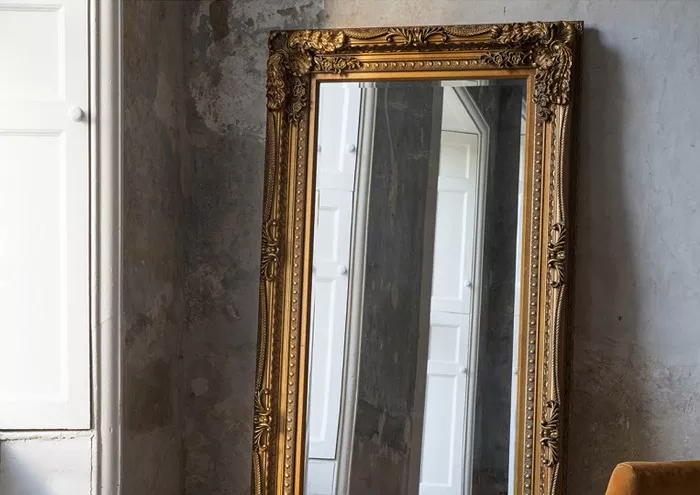Antique mirrors are more than just functional objects; they are historical artifacts that embody the craftsmanship and elegance of their era. However, years of dust, grime, and oxidation can obscure their beauty. Cleaning these delicate pieces requires a precise approach to prevent damage while restoring their original splendor. This guide delves into the best techniques for safely cleaning and maintaining antique mirrors.
Understanding the Composition of Antique Mirrors
What Makes Antique Mirrors Unique?
Unlike modern mirrors, antique mirrors consist of different materials that have aged over time. They typically feature a glass pane backed by a reflective coating, often made of silver, mercury, or tin-lead amalgam. The frames, which may be made of wood, brass, or gilded plaster, also require careful handling.
Why Is Special Care Needed for Cleaning?
The delicate nature of antique mirrors means that using conventional cleaning methods can lead to irreversible damage. Harsh chemicals can erode the reflective backing, while excessive moisture can seep into the frame, causing warping or deterioration. Proper cleaning techniques ensure the longevity of these valuable pieces.
What Are the Essential Tools and Materials for Cleaning?
Before attempting to clean an antique mirror, it is crucial to gather the right materials to avoid unnecessary damage.
Recommended Cleaning Supplies
- Soft microfiber cloths – To avoid scratching the surface
- Distilled water – To prevent mineral deposits
- White vinegar – A natural cleaner that is gentle on antique glass
- Cotton swabs – For detailed cleaning of intricate areas
- Makeup brushes or artist brushes – To remove dust from delicate carvings
- Mild dish soap – For light cleaning without damaging the surface
- Lint-free cloth – For polishing without leaving streaks
- Beeswax or furniture polish – To preserve wooden or gilded frames
What Should You Avoid?
- Ammonia-based cleaners – These can strip the reflective backing
- Paper towels or rough cloths – They may scratch the glass
- High-pressure water sprays – Excess moisture can damage the mirror’s backing
- Excessive rubbing – This can cause flaking or further deterioration
How to Properly Clean an Antique Mirror
Step 1: Dusting the Frame and Glass
Begin by dusting off any loose debris using a soft brush or microfiber cloth. Pay special attention to carved or gilded frames, as excessive pressure can cause chipping.
Step 2: Preparing a Gentle Cleaning Solution
Mix equal parts distilled water and white vinegar in a spray bottle. This solution effectively removes grime without causing damage.
Step 3: Cleaning the Glass Surface
- Lightly dampen a microfiber cloth with the vinegar solution.
- Gently wipe the glass in a circular motion, avoiding excessive moisture.
- If dealing with stubborn spots, use a cotton swab dipped in the solution to carefully remove grime.
- Immediately dry the surface with a lint-free cloth to prevent streaks.
Step 4: Cleaning the Mirror’s Backing
- Never apply liquid cleaners directly to the back of an antique mirror, as moisture can seep into the silvering and cause deterioration.
- Use a soft brush to remove dust and debris.
- If necessary, lightly dab with a barely damp cloth and immediately dry.
Step 5: Restoring and Protecting the Frame
- For wooden frames, apply a small amount of beeswax or furniture polish to maintain the finish.
- Gilded frames should only be dusted; avoid using liquid cleaners as they can strip the gold leaf.
- If the frame has small cracks or loose parts, consider consulting a professional restorer.
How to Handle Common Issues in Antique Mirrors
What to Do About Cloudiness or Fogging?
Over time, antique mirrors can develop a hazy appearance due to oxidation or the breakdown of the reflective backing. Unfortunately, this cannot be remedied with simple cleaning. If the cloudiness is severe, you may need professional resilvering, a process that involves replacing the reflective layer.
How to Remove Stubborn Stains Without Damage?
- Use a mix of mild dish soap and distilled water for sticky residues.
- For ink or paint stains, gently rub with a damp cloth and avoid aggressive scrubbing.
- If dealing with mold, use a diluted solution of hydrogen peroxide, applying sparingly to prevent moisture damage.
How to Prevent Further Deterioration?
- Keep the mirror away from direct sunlight to prevent the silver backing from fading.
- Avoid placing it in humid environments to minimize moisture damage.
- Regularly dust and maintain the frame to prevent deterioration over time.
When Should You Seek Professional Restoration?
If an antique mirror is significantly damaged, professional restoration might be necessary. Restoration experts can safely remove deteriorated silvering, stabilize fragile frames, and preserve the authenticity of the piece.
Signs That Professional Help Is Needed
- Severe black spots or peeling of the silver backing
- Cracks in the glass that compromise structural integrity
- Loose or damaged frame carvings
- Extensive mold or water damage
How to Preserve Your Antique Mirror for Generations
Best Practices for Long-Term Maintenance
- Regular dusting to prevent buildup
- Avoid excessive moisture to protect both the glass and frame
- Use museum-quality glass cleaner when necessary
- Store in a stable environment with controlled humidity
Displaying Antique Mirrors Safely
- Mount mirrors securely to avoid accidents.
- Use felt pads or cushioning if leaning against a wall.
- Keep away from heat sources like radiators or fireplaces.
Conclusion
Cleaning and maintaining an antique mirror requires patience and a gentle approach. By using the right materials and techniques, you can restore its beauty while preserving its historical integrity. Whether you choose to clean it yourself or seek professional restoration, caring for an antique mirror ensures it remains a cherished heirloom for years to come.

